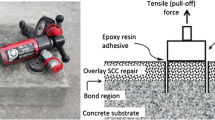Abstract
Methyl methacrylate styrene and acrylonitrile homopolymer as well as copolymer impregnated concrete specimens were subjected to accelerated durability tests in aqueous sulphuric acid, hydrochloric acid, ammonium chloride, sodium chloride, sodium hydroxide, sea water and crude oil media. The effects of such corrosive stagnant environments on compressive strength, flexural strength, strength of transverse rupture and modulus of elasticity have been studied. A durability mechanism has been proposed to account for the observed behaviour of polymer impregnated concrete.
Similar content being viewed by others
References
A. B. Auskern, Brookhaven National Laboratory Report No. BNL-13493, p. 24, US Atomic Energy Commission, 1969.
R. N. Swamy,J. Mater. Sci. 14 (1979) 1521.
K. R. Kirtania, PhD thesis, Indian Institute of Technology, Kharagpur (1984) p. 55.
V. K. Bhattacharya, K. R. Kirtania, M. M. Maiti andS. Maiti, Proceedings of the National Seminar, New Delhi, April 1982. Paper No. III(6).
T. Fukuchi, Y. Ohama andE. Inuishi,Proc. Jpn. Congr. Mater. Res. 21 (1978) 190.
Author information
Authors and Affiliations
Rights and permissions
About this article
Cite this article
Kirtania, K.R., Maiti, S. Polymer impregnated concrete. J Mater Sci 21, 341–345 (1986). https://doi.org/10.1007/BF01144742
Received:
Accepted:
Issue Date:
DOI: https://doi.org/10.1007/BF01144742




